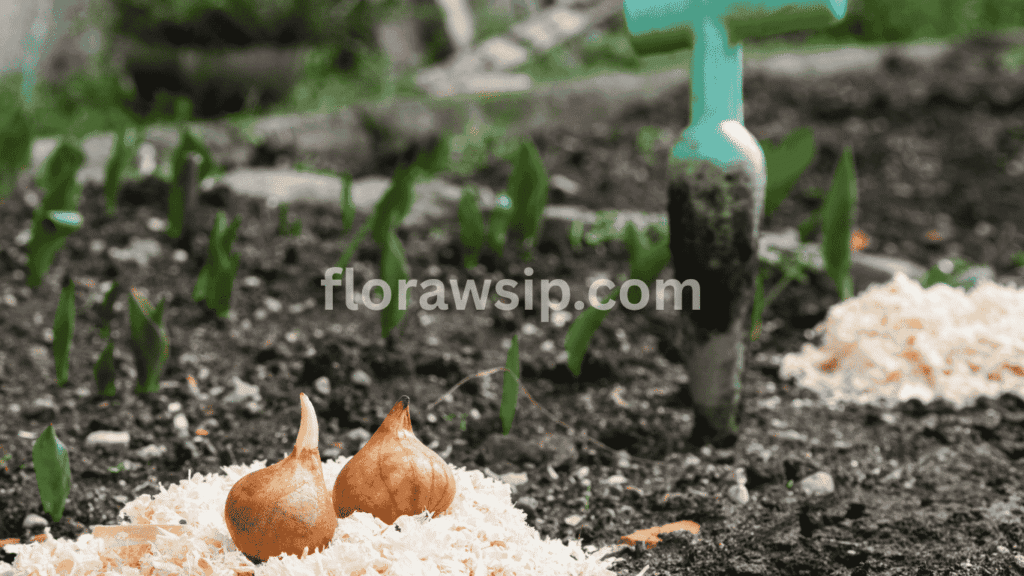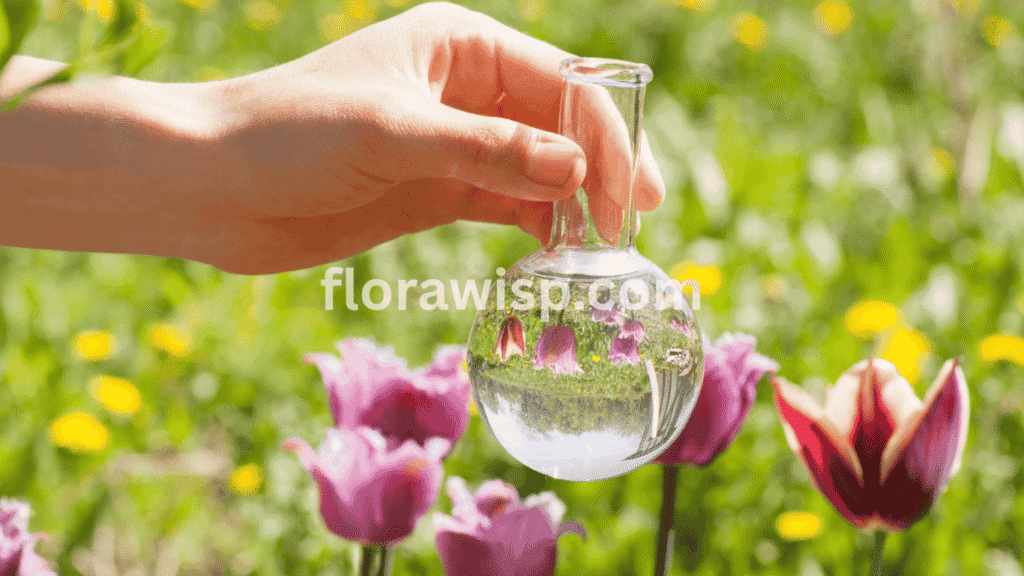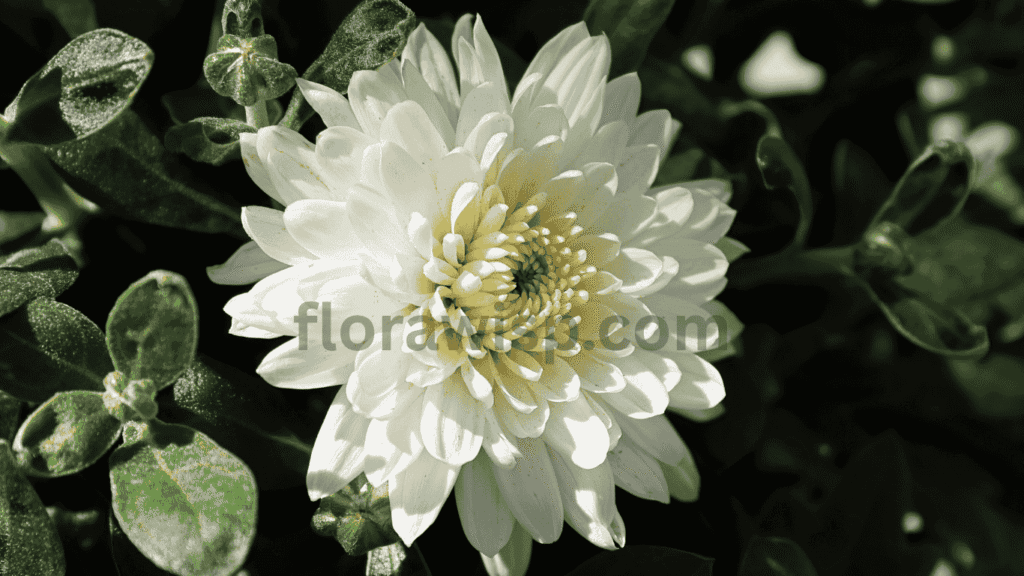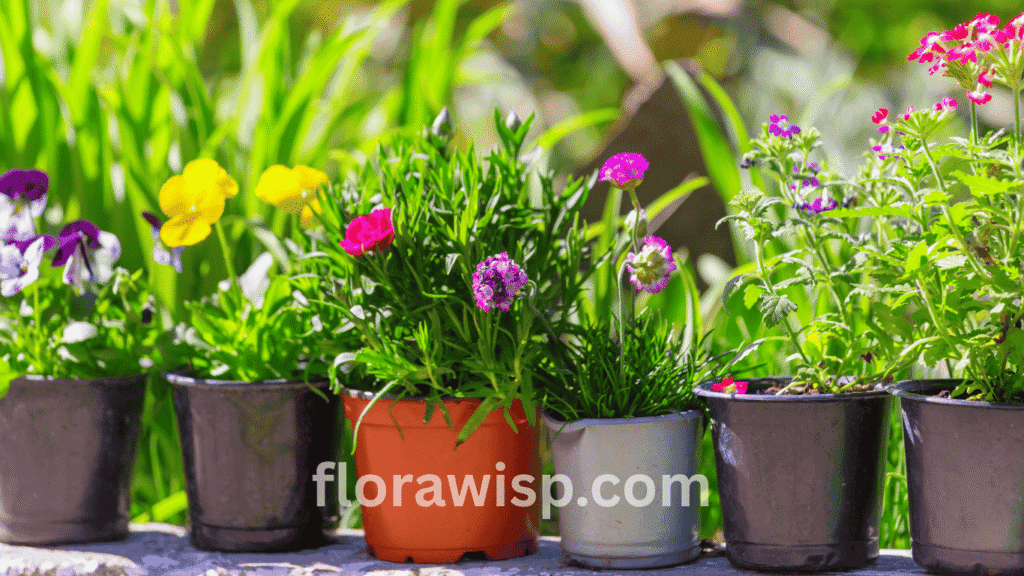When to plant tulip bulbs? Plant them in fall when soil temperatures consistently drop below 55°F, typically between late September and mid-November across most U.S. zones. This timing is crucial for achieving vibrant spring blooms, especially if you’re aiming for dramatic varieties like Black Tulips that require proper chilling to develop their deep, velvety color.
This chilling period is essential for strong spring blooms. In colder zones (3–7), planting can begin as early as late September, while in warmer zones (8–10), bulbs must be pre-chilled in the fridge for 10–14 weeks and planted by late November.
Plant tulip bulbs 6 to 8 inches deep in well-draining soil, spacing them 4 to 6 inches apart. Choose a sunny location with protection from harsh winds. Proper planting depth and spacing improve root stability and bloom size, while compost or bone meal can enrich the soil for better growth.
Water immediately after planting to help bulbs establish, then allow natural winter moisture to support them. Tulips don’t require watering during dormancy. After blooming in spring, deadhead the flowers but leave foliage intact until it yellows to feed the bulb for next year. In warmer climates, treat tulips as annuals unless using heat-tolerant types like Darwin hybrids.
Planting at the right time, with correct soil prep and chilling if needed, ensures vibrant tulip displays, whether you’re gardening in Michigan, Texas, or coastal Carolina.
In This Article
When to Plant Tulip Bulbs in the U.S. by Hardiness Zone
Knowing when to plant tulip bulbs depends on your region’s climate. Tulips need a period of cold dormancy (below 55°F) for about 12–16 weeks to trigger blooming. That’s why fall planting is crucial. You want to give bulbs that cold exposure before the ground freezes.
Here’s a guide I use based on USDA zones:
| USDA Zone | Ideal Planting Time |
| Zone 3 | Mid-September to Early October |
| Zone 4 | Late September to Mid-October |
| Zone 5 | Early to Mid-October |
| Zone 6 | Mid to Late October |
| Zone 7 | Late October to Early November |
| Zone 8 | Early to Mid-November |
| Zone 9 | Mid to Late November |
If you’re gardening in southern states like Georgia or North Carolina, timing becomes even more important. Many gardeners in warmer zones ask:
- When to plant tulips in Georgia? Aim for early to mid-November.
- When to plant tulips in NC (North Carolina)? Late October is ideal for most areas.
To boost success in Zones 8–9, use pre-chilled tulip bulbs for fall planting. You can chill them in your refrigerator for 8–10 weeks before planting.
How to Plant Tulip Bulbs: My Personal Fall Routine
Learning when to plant tulip bulbs was a turning point in my gardening journey. Early on, I lost an entire bed to poor timing and soggy soil. But with each fall season, I’ve fine-tuned a method that delivers consistent spring blooms vibrant, healthy, and full of life. If you’re wondering how to get it right the first time, here’s the exact step-by-step routine I follow here in USDA Zone 7.

1. Understand When to Plant Tulip Bulbs in Your Zone
The best time to plant tulip bulbs is in the fall, once soil temperatures drop below 60°F but before it freezes solid. In most U.S. zones, this means planting between late September and early November. I personally aim for mid-to-late October. This timing gives bulbs a chance to establish strong roots before winter dormancy, which is crucial for healthy spring emergence.
If you plant too early, you risk premature sprouting. Too late, and bulbs might not root at all.
2. Pick the Right Planting Spot
Tulips crave full sun and well-drained soil. Choose a location that gets at least 6 hours of direct sunlight, especially in early spring when most trees are still bare. I avoid low spots in my yard since standing water can rot the bulbs during winter.
If your soil is clay-heavy, amend it with sand or compost to boost drainage. I’ve had the best luck mixing in leaf mold and coarse grit nature’s own drainage solution.
3. Prepare the Soil Deeply
Proper soil prep is non-negotiable. I always dig down 10–12 inches and loosen the soil well. Then I blend in 2–3 inches of aged compost or well-rotted manure. This not only improves structure but also adds slow-release nutrients that support the tulip’s root system over winter.
Tip: Avoid high-nitrogen fertilizers at planting time they can encourage foliage at the expense of flowers.
4. Plant the Tulip Bulbs at the Right Depth and Angle
Place each bulb with the pointed tip facing up. I plant mine about 6–8 inches deep, depending on bulb size. A good rule is to plant three times as deep as the bulb is tall. This helps protect the bulb from frost and squirrels.
I always group bulbs in clusters of 10–15 rather than planting them in rows. This gives a more natural, full-bloom look in spring and trust me, it’s worth the extra effort.
5. Mind the Spacing and Water In
Space bulbs 4–6 inches apart so they don’t compete for nutrients. After covering with soil, I water them thoroughly once to help settle the soil. No need to water again until spring unless you’re facing a dry fall.
For container planting, ensure your pots are deep, well-draining, and left in a cold (but not freezing) place all winter. I’ve had success overwintering tulips in unheated garages or tucked along the north side of my home.
6. Label and Protect Your Planting Area
I always mark the area after planting whether with a small garden tag or a map in my garden journal. Once winter sets in, it’s easy to forget where bulbs are hiding underground.
To deter squirrels, I sometimes cover newly planted areas with chicken wire and remove it in early spring.
Mastering when to plant tulip bulbs and how to plant them has made all the difference in my flower beds. Once I aligned my planting time with local temperatures and fine-tuned soil prep, the results were consistent: strong stems, full blooms, and early color when most of the garden is still asleep.
If you’re just starting out, keep it simple, choose a sunny spot, plant at the right depth, and stick to that optimal fall window. Your future spring garden will thank you.
How Deep to Plant Tulip Bulbs for Strong Blooms
Over the years of planting tulips across different USDA zones, I’ve learned firsthand how critical depth is for healthy, upright tulip growth. If you’ve ever had tulips flop over after a light breeze or bloom too early only to get hit by frost, chances are they were planted too shallow. When fellow gardeners ask me when to plant tulip bulbs, I always remind them that how deep you plant matters just as much as when.
The 3x Rule: Simple and Reliable

A good rule of thumb I follow is planting tulip bulbs at three times their height. It’s a method that has consistently given me sturdy stems and delayed sprouting until the right time in spring.
- Small tulip bulbs (dwarf or specialty types): Plant 4–5 inches deep
- Large tulip bulbs (standard Darwin hybrids or Triumph types): Plant 6–8 inches deep
This depth helps protect bulbs from surface temperature swings, especially in regions with unpredictable winter thaws.
Mistakes I’ve Made, and What You Can Avoid
In my early gardening days, I planted bulbs just 3–4 inches deep because it was easier to dig. That shortcut led to early shoots in January and floppy stems by April. Those blooms were weak and didn’t last long. Since then, I’ve relied on a tulip planter tool with a depth gauge to get it right every time. It’s worth the small investment.
If you’re looking for when to plant tulip bulbs, late fall when the soil is around 50°F is perfect. But don’t overlook depth in the process. Shallow planting might get you early sprouts, but strong, resilient blooms come from deeper, well-insulated bulbs.
Planting in Pots or Raised Beds? Go Deeper
For containers or raised beds, I always add an extra inch or two of depth. It acts as insulation and keeps the bulbs stable during winter freezes. With the right depth, your tulips planted in pots can be just as bold and beautiful as those in garden beds.
Can You Plant Tulips in Spring?
As a gardener who’s worked with tulips across several planting seasons, I’ve learned that when to plant tulip bulbs truly shapes the outcome of your blooms. While fall remains the gold standard, spring planting can still work just with managed expectations.

Why Timing Matters for Tulip Bulbs
Tulips need a cold dormancy period, what we call vernalization, to trigger flower production. When you plant tulip bulbs in fall (usually from October through December, depending on your USDA Zone), they naturally get the chill they need from winter. This is especially crucial in colder regions like Zones 3–6. If you’re aiming for classic varieties like White Tulips, this cold treatment becomes even more essential to ensure vibrant spring blooms.
Spring Planting is Possible But Needs Planning
If it’s early spring and your soil is still workable, you can plant tulips using pre-chilled bulbs. I’ve done this myself in Zone 7 by refrigerating bulbs for about 10 to 12 weeks (stored in a breathable paper bag away from produce). The result? I got healthy foliage and a few shy blooms, not the full spring show, but far better than leaving the bulbs unused.
For those in warmer climates Zones 7 to 9 late planting in February or early March is still an option if the bulbs were pre-chilled. Just make sure to get them in the ground before temperatures warm up too much, as tulips struggle with early heat.
What to Expect in Reality
Tulips planted in spring might not bloom their first year or may only produce leaves. But they can naturalize and bloom the following season if the bulbs are healthy and cared for post-planting.
I’ve made the mistake of planting too deep once in a late spring attempt, thinking it might help simulate colder soil. That just delayed growth. A depth of 6 to 8 inches worked best for me, paired with well-draining soil and light morning sun.
If you’re deciding when to plant tulip bulbs, fall is ideal but spring planting can still give your garden a hopeful start if done right.
Best Companion Plants for Tulips
In my years of growing tulips across different USDA Zones, I’ve learned that choosing the right companion plants makes a huge difference not just for garden aesthetics but for the overall health and longevity of your tulip displays. The secret is pairing tulips with plants that bloom either earlier, simultaneously, or shortly after, and that won’t compete for nutrients when tulips need to store energy.
Tried-and-True Companion Plants I Recommend

- Forget-me-nots: These low-growing blue beauties bloom just as tulips hit their peak, creating a soft, cloud-like carpet under taller tulip stems. They reseed easily and return reliably year after year.
- Pansies and Violas: Ideal for early-season color, these cool-weather favorites hold up well in spring beds and don’t overshadow tulips. I tuck them in around the edges of my planting areas.
- Daffodils: Since daffodils and tulips thrive in similar conditions and bloom around the same time, planting them together extends the bulb season. Plus, daffodil bulbs are critter-resistant offering a bit of protection for your tulips.
- Hostas and Daylilies: After tulips finish blooming, these perennials fill in the space with lush foliage and late-spring color. Their growing cycle helps hide the fading tulip leaves, which should remain untouched for at least six weeks after blooming. This helps the bulbs recharge for next season.
I always recommend using a tulip planter to keep your bulbs spaced properly and avoid damaging nearby perennials. Knowing when to plant tulip bulbs is key, but just as important is planning the entire garden bed for year-round interest and bulb health.
Strategic companion planting ensures that your tulip garden doesn’t look bare once blooms fade and helps maintain a vibrant, thriving landscape from early spring through summer.
Choosing and Buying Quality Tulip Bulbs
Knowing when to plant tulip bulbs is only part of the equation; buying the right bulbs is just as critical to a successful bloom. After decades of planting tulips across various USDA Zones, I’ve learned that high-quality bulbs give you the best return vibrant color, strong stems, and dependable emergence year after year.
What Makes a Tulip Bulb Worth Buying?
Always choose bulbs that are:
- Firm to the touch: no mushiness or shriveling
- Free from mold or soft spots
- Heavy for their size: a sign of dense, healthy tissue
- With intact skins to protect them from rot
Avoid any bulbs that show signs of sprouting prematurely, especially if you’re preparing for fall planting, which is the ideal time when to plant tulip bulbs for spring blooms in most regions.
Types of Tulip Bulbs to Consider
In my own gardens, I’ve had the best results with:
- Pre-chilled bulbs – Essential for warm USDA Zones (8–10) where natural chill hours are insufficient
- Heirloom varieties – These give unique, historic blooms and tend to naturalize well
- Organic bulbs – Perfect if you’re growing in eco-conscious or child-friendly gardens
- Mass-market hybrids – Great performers for beginners or large displays
Each type has its own charm and planting behavior, so choosing based on your climate and design goals is key.
Where to Buy Tulip Bulbs for Planting
Over the years, these have been my go-to sources:
- Specialty retailers like Breck’s, John Scheepers, and Colorblends for premium, large-caliber bulbs
- Online nurseries such as Eden Brothers and DutchGrown for wide selection and reliable shipping
- Local garden centers, especially in fall, often carry regionally appropriate bulbs
If you’re serious about results, make sure you’re selecting tulip bulbs for planting specifically marked for fall shipment. The timing of your purchase should always align with when to plant tulip bulbs in your USDA Zone typically late September through November, depending on your climate.
How to Care for Planted Tulips After They Bloom
Once tulips finish their vibrant display, their care doesn’t stop. In fact, this stage is crucial if you want healthy blooms next season. After years of planting tulips in my USDA Zone 5 garden, I’ve learned that how you treat them after flowering can make all the difference.
1. Deadheading Spent Blooms
As soon as your tulips fade, snip off the flower heads. This keeps the plant from wasting energy on seed production and instead pushes it back into bulb development. I’ve noticed stronger regrowth in spring when I do this consistently.
2. Leave the Foliage Alone
Don’t rush to cut down the leaves. Let them yellow and die back naturally around 6 weeks. Those green leaves are busy photosynthesizing and storing energy back into the bulb. Premature cutting has cost me blooms in the past, so patience pays off here.
3. Smart Watering
Once flowering ends, reduce watering. Tulips dislike wet feet, and too much moisture can lead to bulb rot. In my early gardening days, I learned this the hard way during a particularly rainy May the bulbs turned mushy underground. Since then, I’ve cut back watering post-bloom and seen better survival rates.
4. Fertilize Right After Bloom

Apply a balanced bulb fertilizer as soon as the flowers fade. Feeding at this stage strengthens the bulb for the next growing cycle. I use a granular 10-10-10 mix and work it into the topsoil.
5. To Lift or Not to Lift?
In colder climates like mine, tulips can often be left in the ground especially when planted deep. But in warmer zones where winter chill is limited, you might need to dig up the bulbs and refrigerate them to mimic cold dormancy. This ties directly into planning when to plant tulip bulbs for optimal spring growth, especially if you want to create a vibrant Tulip Bouquet next season.
I’ve had consistent success with perennial tulips by planting 6–8 inches deep, fertilizing every season, and letting nature take its course. These steps may seem small, but they make a big difference in bulb strength and bloom quality.
FAQs
Q1: Are tulips perennial plants?
Yes, tulips are technically perennials, but most gardeners treat them as annuals in the U.S. unless conditions are ideal. While tulips can return every spring, in reality, only specific types like Darwin hybrids consistently rebloom. In warmer USDA zones (7 and up), you may need to refrigerate bulbs for 10–12 weeks before planting to simulate winter. From my gardening experience, factors like well-drained soil, proper planting depth (6–8 inches), and post-bloom foliage care heavily influence reblooming. Without these, tulips often produce smaller blooms or none at all the following year.
Q2: When do you plant tulip bulbs?
You should plant tulip bulbs in fall, ideally 6 to 8 weeks before your region’s first hard frost. That typically means planting between late September and mid-November, depending on your local USDA zone. This timing gives bulbs enough cold exposure and root development before the ground freezes. I always use a soil thermometer to ensure the temperature has dropped below 55°F before planting. Starting too early can lead to fungal issues, while late planting might not give roots enough time to establish for strong spring blooms.
Q3: Best time to plant tulip bulbs?
The best time to plant tulip bulbs is when soil temperatures consistently drop below 55°F usually mid to late October in most regions. This chilling period is essential for triggering spring blooming. Based on both data and field results, planting too early in warm soil encourages rot, while too late risks shallow rooting. I always track soil temps starting in September using a $10 probe from my local garden center. It’s the simplest way to maximize bloom success and bulb health.
Q4: Is it worth it to invest in a Tulip planter tool?
Yes, a tulip planter tool is 100% worth the investment if you’re planting more than a handful of bulbs. It saves time, ensures consistent depth (which is critical for bloom quality), and dramatically reduces strain on your back and wrists especially in heavy clay or compacted soils. I’ve used both handheld and long-handle types and wouldn’t go back. For large-scale beds, it easily doubles planting speed. Many tools even come with depth markers, helping you hit that 6–8 inch sweet spot every time.
Q5: where to buy Tulip plants for sale?
You can buy high-quality tulip plants and bulbs from trusted online nurseries like Eden Brothers, Breck’s, or DutchGrown, as well as local garden centers during fall. I recommend choosing bulbs that feel firm and dry, without mold or soft spots signs of disease or poor storage. In my experience, ordering early (August–September) gives you access to rare varieties and fresher stock. Many online suppliers also ship at the right planting time based on your zip code, which removes the guesswork.
Conclusion:
Tulips are one of spring’s greatest rewards and knowing when to plant tulip bulbs is the first step to enjoying that beauty in full bloom. From my own decades in the garden, I’ve learned that timing, depth, and aftercare matter just as much as the bulb itself. If you’re looking for a guide to vibrant varieties and planting tips, don’t miss my detailed article on pink tulips.
So grab your bulbs, prep your beds, and trust the process. Spring will thank you.
References
South Dakota State University Extension – Tulips Bring Early‑Season Color
Texas A&M AgriLife Extension – Tulip Bulb Forcing Guide (South Texas)
Gardener, M.Sc. Horticulture
Elara Bennet is a gardening writer from Austin, TX, passionate about sustainable lawns and blooms. Read full bio →








